Different Types of Bonsai Trees: The Definitive Guide
When you enter the wonderful world of these miniature landscapes, you may wonder how to choose from the many types of bonsai trees available.
As in wild nature, there are hundreds of species in different parts of the world. Some are more popular than others, you’ll only select some of them for specific applications. We’re taking a three-pronged approach towards a holistic response for various bonsai trees.
Firstly, we’ll show you the broad categories associated with trees in general. We’ll follow this up by discussing the different types in terms of classes and taxonomy most popular among enthusiasts. Finally, we’ll look at which of these genera and species are the top ones to bonsai for different situations.

Table of Contents
Introduction to Various Types of Trees
Before we go into extensive detail on the different types of bonsai trees, we’d like to show you the different categories they fall into. It will help paint a picture of how they’re related, as it may assist you in picking the type that will suit you. It also aids many people in identifying what tree it is when they receive one as a gift or grow one from seed or cutting.
Deciduous
This type of tree is well-known for leaves that change color or fall during autumn and winter. When spring arrives, they are replaced with new stems and leaves towards flowering in the summer. It’s an annual cycle that’s beautiful to behold, as can be witnessed with the Japanese Maple and English Oak.
Broadleaf Evergreen
As a counterpart to the deciduous trees, you’ll find the broadleaved evergreen species. They have wide leaves that remain green all year round, and there’s a low chance that you’ll see any of them fall. They represent robust health through every season, while new growth won’t appear in winter. Good examples include the Chinese Elm and most Ficus trees.
Conifer
Conifer trees have needles and scales for foliage, as is most notable in Pine and Junipers. For the most part, they are evergreen, and you shouldn’t see any color changes or leaf droppings during the colder months. They’re more resilient to colder temperatures, and some of them are popular as Christmas trees.
Deciduous Conifers
Finally, we have the conifer deciduous category. While most conifers are evergreen, there are some that change color or drop their leaves in fall and winter. They put on a stunning display, with some hues varying between orange and brown. Some examples include Dawn Redwood and Bald Cypress.
Definitive Guide to Types of Bonsai Trees
Now that you have a better idea of the broader classifications, let’s get to the heart of our guide on different types of bonsai trees. We’re going to become a bit more technical here, looking at various genera and species you can grow into a miniature tree.
You’ll see various groups listed below where we’ll provide information on each type. We’ll keep them together in terms of conifers and broadleaf trees.

Types Of Pine Trees
There are plenty of pines that are perfect as types of bonsai trees. In general, you’ll find two versions of this evergreen conifer genus. The first has one growth flush within a year, compared to the one that has two. The latter usually develop another set of stems and leaves when storms break their candles, notably due to severe weather in Japan.
Pine bonsais are popular all over the world, while the trees mostly thrive in the northern hemisphere. There are many styles that enthusiasts love to use, such as formal upright, slanting, cascading, and exposed root. These trees are easily identifiable by their needles that group in bundles from two to five.
Here are some examples of the most popular types of pine trees as bonsais:
- Japanese Black Pine
- Japanese Red Pine
- Japanese White Pine
- Scots Pine
- Ponderosa Pine
- Mountain Pine
- Stone Pine
Types Of Cedar Trees
When it comes to conifer bonsai, there are four stunning species you can grow. While it’s rare to find one as a bonsai in local stores and online, they have beautiful long needles that are often green or green-blue in color. These trees love to grow in the Mediterranean and Himalayan regions, but you may find some countries where someone has developed one from a cutting.
Forming part of the Pine family, the Cedar genus has trees with similar cone designs to fir trees, which is what makes them appealing as bonsais. The resin has a spicy scent to it, adding a new layer of odors to your bonsai nursery all year round. It’s one of the evergreen conifers, so you can expect beautiful needles in every season.

These are the popular types of cedar trees grown as bonsais:
- Atlas Cedar
- Lebanon Cedar
- Himalayan Cedar
- Cyprus Cedar

Types Of Fir Trees
Another member of the Pine family, there are about 56 species that grace these evergreen conifer trees. What makes them stand out from the Pine genus is that the leaves look like they’re attached to branches via suction cups. The cones have a distinctive shape and size, which helps with identifying them.
These trees can be challenging to grow as bonsais, which is why we don’t recommend them for beginners. Maintenance requires the utmost care, while you’ll also need to ensure you protect them from pests and diseases. Still, they present a beautiful structure and design as a miniature shape.
Despite the name, the Douglas Fir is not a true fir, but rather, a false hemlock tree.
Here are some of the common types of fir trees as bonsais:
- Silver Fir
- Greek Fir
- Pacific Silver Fir
- Faber’s fir
- White fir
Types Of Spruce Trees
One more Pine family member worthy of mention is the spruce genus. Containing 35 species, it contains evergreen conifers that are notably popular as Christmas trees. Their conical shapes are stunning to behold, while many of them have needles with blue-green sheens.
The cones tend to bend downwards, and they make a beautiful display on bonsai trees. Among the selection is a Norway Spruce that’s 9,550 years old, said to be the oldest living tree. However, they can be challenging to style and wire due to how the needle leaves form and cluster.

There are many enthusiasts eager to grow these types of spruce trees as bonsais:
- Alberta Spruce
- Black Spruce
- Colorado Blue Spruce
- Purple Cone Spruce
- Korean Spruce
- Norway Spruce
- Green Dragon Spruce

Types Of Cypress Trees
Also known as Cupressaceae, Cypress is the name given to a family of trees with similar features. These evergreen trees consist of several genera, some of which like dry regions while others prefer more swampy, wet locations. There’s also a genus of cypresses called Cupressus after which the family is named, which contains about 25 species.
Due to the varying preferences, some are evergreen conifers while others are deciduous. The trees in this family have a majestic appearance, some towering with conical shapes. For the most part, they serve well as formal upright styles. The foliage color depends on the species and region, but it ranges between green and a light green-blue.
While there are many species, here’s a quick list of the popular types of Cypress trees as bonsais:
- Italian Cypress
- Bald Cypress
- Swamp Cypress
- Monterey Cypress
- Leyland Cypress
- Arizona Cypress
Types of Juniper Trees
As a member of the Cypress family, we felt the need to single out the Juniper genus. If you’ve ever watched the Karate Kid movies, you’re very familiar with these trees. There are about 57 species spread across the world, and it’s one of the most popular trees to grow as a bonsai due to its beautiful foliage and scent.
The needles have a scale-like appearance, which sets them apart from most evergreen conifers. There are also various colors among the species, some with a blue-green sheen that enthusiasts love. While you can obtain different Junipers in many countries, traditionalists prefer ones grown in the heart of Japan.

Here are some of the most popular types of Juniper trees as bonsais:
- Chinese Juniper
- Common Juniper
- Sabina Juniper
- Blaaws Juniper
- San Jose Juniper
- Creeping Juniper
- Garden Juniper
- Himalayan Juniper
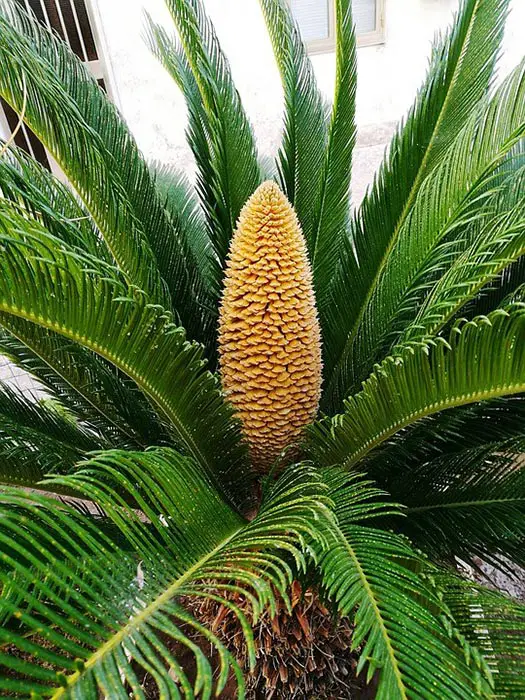
Types Of Palm Trees
When one thinks of palm trees, you’ll know doubt imagine the tall towers with fan-like leaves you’d usually find along the beach in Miami. These are actually part of the true palm family, Arecaceae. Sadly, they don’t have a shape that’s fit for bonsai. However, there are two ‘imposters’ that look like palms that do the trick.
The first is the Ponytail Palm, which forms part of the asparagus family. The second is the Sago Palm that’s in the cycad family. They’re very popular types of palm trees as bonsais in countries like Japan, as it’s easy to maintain the small shape and thick trunk. Their leaves are beautiful, making a gorgeous addition to any bonsai display.
Types Of Maple Trees
The Acer genus under the Soapberry family, Sapindaceae, is one of the marvels of the bonsai world. These trees have stunning palmate leaf structures, and you’ll witness an array of different colors from these deciduous broadleaf species through the seasons. The winged fruit are also a wonder to behold, even on your small trees.
Many collectors enjoy obtaining as many different species as possible so that there’s a gorgeous rainbow of colors throughout the year. In nature, you’ll find about 106 maple species worldwide. While it a massive number, not all of them are suitable or preferred as bonsais by traditionalists.

Here’s a brief summary of the popular types of maple trees as bonsais:
- English Maple
- Paperbark Maple
- Japanese Maples >
- Deshojo Maple
- Katsura Maple
- Nomura Maple

Types Of Oak Trees
If you thought the Maple genus was huge, Quercus has over 500 species on its list within the Fagaceae beech family. Many of them are ideal for bonsais, as you can trim and maintain the unique leaves in small sizes. They are also incredibly resilient with impressive trunks and rough barks, while the foliage puts on a stunning display.
While most of the oak trees are deciduous, there are some with evergreen properties. The most exciting aspect besides the leaves is the acorns, adorning these types of bonsai trees like small Christmas decorations. Both the leaves and acorns contain tannic acid as a solid defense against pests and fungus.
You’ll find a shortlist of the top types of oak trees for bonsais here:
- Southern Live Oak
- Blue Shrub Oak
- English Oak
- Turkey Oak
- Northern Pin Oak
- American White Oak
- Golden Oak
- Japanese Evergreen Oak
Types Of Magnolia Trees
With a smaller range of about 200 species, the Magnolia genus and family are well known for their stunning flower display. Even as a bonsai, these small petals look like small stars on the tree, bringing beauty to any space. While it may be rare to find them as bonsais in stores, there are many enthusiasts that try to cultivate them.
In a way, the flowers are reminiscent of peach trees with their colorful displays. If you place your magnolia bonsais outside in your garden, you’re sure to see butterflies, bees, and other small insects attracted to them. These are hardy trees that enjoy any style and can survive various conditions.

Despite the massive number of species, there are only a few favored for being the best types of magnolia trees as bonsais:
- Star Magnolia
- Purple Magnolia
- Sweetbay Magnolia
- Saucer Magnolia

Types Of Birch Trees
The Birch family, Betulaceae, has several popular genera you may be familiar with, such as hornbeams, hazels, and alders, all of which have species that are ideal as types of bonsai trees. When looking at the Betula or Birch genus alone, there are up to 60 taxa with several subgenera, revealing just how massive the range really is.
There are five main groups in this genus, namely, Wintergreen Oil, Large-leaf, Costate, Typical, and Dwarf birches. The Typical subgenus is the one that holds most of the top birch bonsais, while there are a few from the others. They’re well-known for their hardwood and deciduous properties, making them hardy trees for all seasons.
We’ll narrow down the list to some of the more popular types of birch trees for bonsais:
- Downy Birch
- Silver Birch
- Dwarf Birch
- Heart-leaf Birch
- River/Black Birch
- Chinese Red Birch
Types Of Willow Trees
Like Magnolia and Birch, the Willow has its own family with genera under it, Salicaceae. While there are three subfamilies and six tribes, our main focus is the Willow genus, Salix. This group alone has over 400 species, which goes to show how widespread and large it really is.
However, not all of them are popular types of bonsai trees. Some can be challenging to cultivate, even in the right conditions. Some of them are low-growing creepers, while others are ideal as small trees. These deciduous species enjoy regions in the Northern Hemisphere and are well known for their drooping leaves and watery sap.

Here are some of the more common types of willow trees as bonsais, with the first one being the most popular:
- Weeping Willow
- White Willow
- Goat Willow
- Dappled Willow
- Peach-Leaf Willow
- Purple Osier Willow
- Coyote Willow
- Scouler’s Willow
- Almond Willow
- Arctic Willow
- Dwarf Willow

Types Of Dogwood Trees
Cornaceae is well-known for its family of beautiful flowering trees, containing only two genera. Of these, the genus Cornus is popular for its range of dogwoods. There are about 60 deciduous species within it, made popular by the stunning berries, blossoms, and bark. They are found in many parts of the world, mostly in Eurasia, Japan, China, and North America.
The main attraction for dogwoods as bonsais is the blossoms. They bloom in outstanding masses, sometimes covering all the leaves in a stunning display. They’re also easy to propagate from seeds and cuttings. You can maintain and prune them without too much effort, and we recommend obtaining various species for a beautiful collection.
For some of the best types of dogwood trees as bonsais, you can’t go wrong with these:
- Kousa Dogwood
- Cornelian Cherry
- Japanese Cornelian Cherry
- Flowering Dogwood
- Pacific Dogwood
- Canadian Bunchberry
- Gray Dogwood
- Mountain Dogwood
- Swedish Cornel
Types Of Fruit Trees
While most flowering trees produce fruit in some form or another, we’re mostly discussing it in the context of popular commercial fruit sold in local stores and markets. Many people enjoy growing these as bonsais so that they can eat the small fruit when they become ripe or use them in meals. There are way too many tropical and citrus families and genera to list here, and we may create a separate article for it.
For now, we’re merely going to mention the joy of seeing the first fruit appear on your bonsai tree. The main reason it’s so exciting is due to the fact that not many bonsais bear fruit. In some cases, they don’t thrive as small trees or the conditions aren’t right. However, it’s very possible to cultivate fruit on them.

Since the number of species to mention is too long for this guide, we’re going to list our top types of fruit trees for bonsais:
- Pomegranate
- Cherry
- Apple
- Syzygium
- Orange
- Lemon
- Crabapple
- Kumquat
- Japanese Winterberry

Types Of Ficus Trees
If you’re a beginner at the art of developing miniature landscapes, someone has probably told you to get a Ficus. It’s one of the most popular types of bonsai trees to grow, as it’s hardy and can survive most conditions. It’s part of the Mulberry family, Moraceae, and has over 850 species in it, making it an incredibly massive genus.
While it’s also a well-known fruit tree, we decided to single it out among the others. Such is the variety among enthusiasts, that you’ll often find it among local and online stores. It can be incredibly forgiven and live for hundreds of years.
Of all the typical ones your find, these are the most common types of ficus trees as bonsais:
- Weeping Fig
- Natal Fig
- Australian Small-Leaf Fig
- Rubber Fig
- Cape Fig
- Sacred Fig
- Wild Fig
- Japanese Fig
- Golden Gate Ficus
- Ginseng Ficus
- Taiwanese Ficus
Types Of Redbud Trees
Redbud trees are a small genus of 10 species that form part of the pea/bean family, Fabaceae. If you’re wanting to practice some patience, we recommend growing some of these. They take about 15 years to mature, and you’ll need to prune carefully due to the structure of the foliage.
The most outstanding feature is the cluster of flowers that form as soon as spring arrives. Your bonsai will glisten as the tiny petals reach for the sun, creating a gorgeous display. There are even some fossils that date back to ancient times, which shows you how long they’ve been around.

Feel free to browse our list of the best types of redbud trees as bonsais:
- Eastern Redbud
- Chinese Redbud
- Yunnan Redbud
- Mexican Redbud
- Afghan Redbud
- Judas Tree

Types Of Ash Trees
The Ash genus is a popular group of trees in the Olive family, Oleaceae, with up to 65 species. Their well-known for their samara, which is a term used for the ‘helicopter seeds’ they bear. While most of them are deciduous, there are subtropical species with evergreen properties.
One of the most outstanding features is the contrast between the thick branches and feathered leaves. While it can be challenging, they make excellent specimens for beautiful ramifications. Their delicate flowers also put on a stunning show during spring and summer.
We’ve selected some of the best types of ash trees as bonsais for you to peruse:
- European / Common Ash
- Chinese Ash
- White Ash
- Green Ash
- California Ash
Types Of Elm Trees
The Elm is another range of trees that has its own family name, Ulmaceae. While there are several genera in this group, the Elms are by far the most popular as bonsais. There are about 35 species, mixed between deciduous and semi-deciduous. They are used in landscaping due to their beautiful forms in several countries.
Bonsai enthusiasts love Elm trees for their delicate leaves and stunning foliage designs. Some of them produce scaling barks, which gives them a gorgeous appearance. Many of them may become infected by the Dutch Elm disease if not careful, while there are some that are resistant to it.

While the first one in our list is certainly the most popular, you can use other types of elm trees as bonsais:
- Chinese Elm
- Siberian Elm
- White Elm
- Rock Elm
- Japanese Elm

Types Of Poplar Trees
The Populus genus has about 35 deciduous species worldwide, covering poplar, cottonwood, and aspen subgroups. Many of them have unique designs, such as silver poplar with green and white leaves and diamond marks on the bark, found in countries like Morocco, Poland, and Armenia. Poplar seeds have fine hairs around them, which makes them disperse more easily with the wind.
Poplars are popular as bonsai due to their strong trunks and dense foliage. The only downside is that they don’t live as long as other species, so don’t expect them to survive for hundreds of years. Still, they make beautiful specimens in your collection thanks to the varied leaf designs and colors.
Here’s our quick list of the top types of poplar trees as bonsais:
- White / Silver Poplar
- Black Poplar
- Balsam Poplar
- Chinese Necklace Poplar
- Japanese Poplar
- Yunnan Poplar
Types of Succulents
While bonsai traditions stem from using woody species, there are plenty of succulents used too. They enjoy pruning, and you can easily plant the cuttings to grow more of them. Some of them form hard barks that make them look like tiny trees.
The list of succulent species used as bonsais is varied, and there are many genera containing popular specimens. For example, the Jade plant and Crassula bonsai are often seen in nurseries or Instagram feeds for their beautiful display of leaves and flowers.

Here’s a few examples of the best types of succulents as bonsais:
- Portulacaria Afra
- Various Crassula species
- Sedums
- Various Pachycauls
Which are the Best Trees to Bonsai?
While we’re sure the above lists of the different types of bonsai trees is helpful, it doesn’t really aid you when you want one for a specific situation. Knowing which is the best one to buy will depend on several factors. For instance, you might want to keep it indoors or in your bathroom, or you’re aiming for one with gorgeous flowers.
To assist you with your decision, we’ll take a look at various scenarios and recommend a few species that would suit them.
Bonsais for Beginners
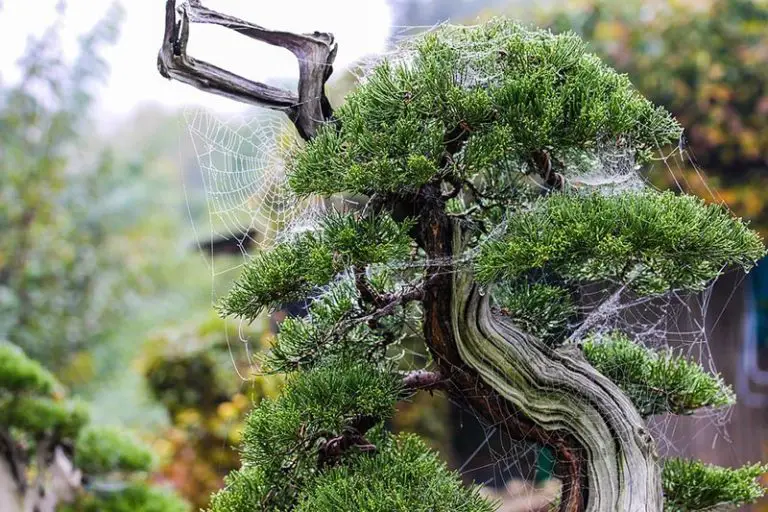
It can be challenging when you’re a beginner to select a bonsai that will survive the first year while you learn to care for it. Fortunately, there are several species that are forgiving. Even if you neglect it for a day or two, it will bounce back when you give it some love and attention again. Here’s a quick list of the ones most suited to beginners.
- Chinese Elm (Ulmus parvifolia)
- Any Ficus
- Small Leaf Jade (Portulcaria afra)
- Garden Juniper (Juniperus procumbens ‘Nana’)
- Littleleaf Cotoneaster (Cotoneaster microphyllus)
Low Light Indoor Plants

It’s no secret that bonsais need loads of sunlight to perform photosynthesis. However, not everyone has the luxury of spaces flooded with natural light. Fortunately, there are some species that can survive in these conditions or even with the assistance of a grow light.
- Rubber Tree (Ficus elastica)
- Lucky Bamboo (Dracaena braunii)
- Norfolk Island Pine (Araucaria heterophylla)
- Madagascar Dragon Tree (Dracaena Marginata)
- Hawaiian Umbrella (Schefflera arboricola)
Indoor Bonsais
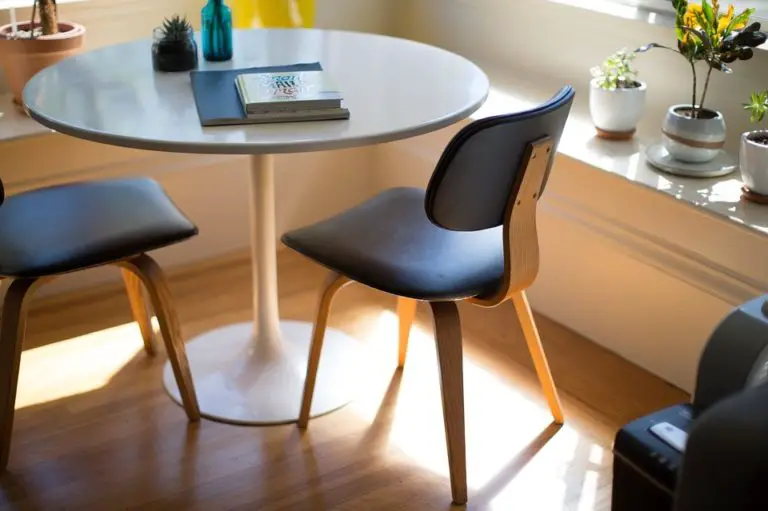
While most bonsai species enjoy the full sun outdoors, there are some that don’t. Their leaves burn, or the direct light has a negative impact on the bark or flowers. These trees are ideal as indoor bonsais, as long as you have some light filtering into the area.
- Weeping Fig (Ficus benjamina)
- Dwarf Umbrella (Schefflera arboricola)
- Chinese Elm (Ulmus parvifolia)
- Dwarf Pomegranate (Punica granatum)
- Snow Rose (Serissa japonica)
- Fukien Tea (Ehretia microphylla)
Apartment Bonsais

Knowing which bonsai you can grow in your apartment will depend on the conditions. Do you have any light, how much space do you have, and is there perhaps a balcony or small garden attached to it? Based on these factors, you could aim for any of the indoor or low light options above. We’ll add a few more below you can look at.
- Wild Olive (Olea sylvestris)
- Firethorn (Pyracantha angustifolia)
- Brazilian Pepper (Schinus terebinthifolius)
- Ginseng fig (Ficus retusa)
Bathroom Bonsais
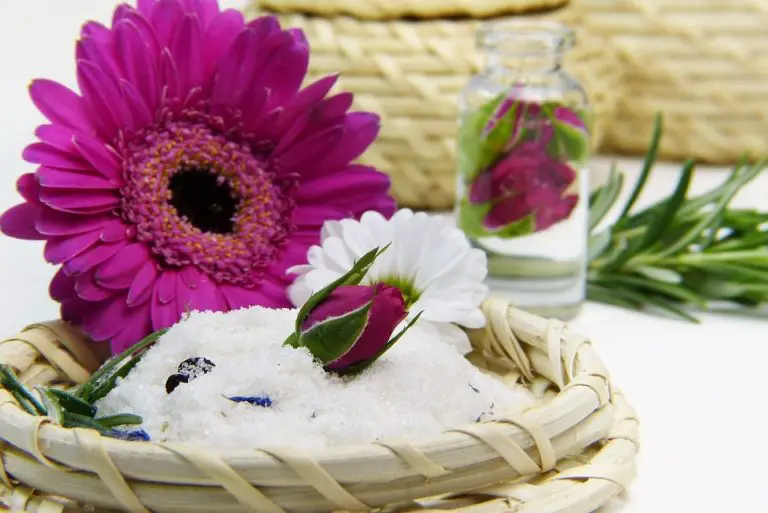
If you want to decorate your bathroom with plants, there are some bonsais that would love the extra humidity created in the room. However, the excessive heat and damp conditions don’t suit many species. You should only focus on the trees that are known to thrive in these situations, such as the ones in the list below.
- Money Tree / Guiana Chestnut (Pachira aquatica)
- Sacred fig (Ficus religiosa)
- Hawaiian Umbrella (Schefflera arboricola)
- Ponytail Palm (Beaucarnea recurvata)
Bonsais for Small Spaces
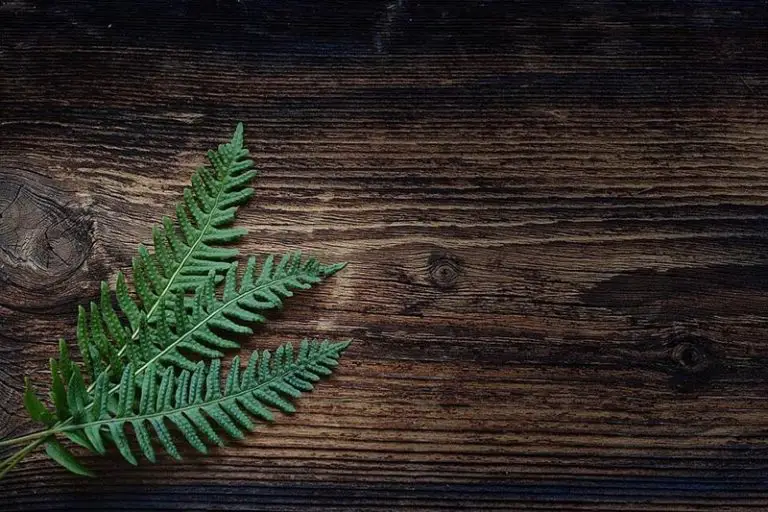
Sometimes, you just want a small bonsai to compliment your bookrack or coffee table. While you can prune almost any tree to the right size, not all of them look stunning in that form. Bonsai terrariums also work well in these situations. We feel that conifers do the trick when it comes to these tiny spaces, while one or two broadleaf trees will also do.
- Wild Olive (Olea sylvestris)
- Snow Rose (Serissa japonica)
- Italian Cypress (Cupressus sempervirens)
- Chinese Juniper (Juniperus chinensis)
- Scots Pine (Pinus sylvestris)
- Crassula (Crassula sarcocaulis)
Growing Bonsais for Meals
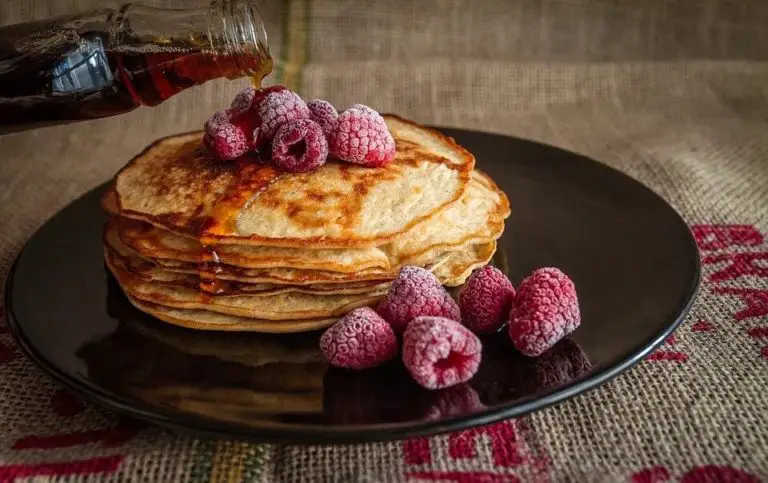
Some people enjoy tasting the fruit of their labor, and we mean this literally. There are several fruit trees that immediately come to mind if you want to add the small items to a side dish. They’re also delightful to pick and nibble on, which gives a refreshing taste during late design pruning moments.
- American Beautyberry (Callicarpa americana)
- Chinese waterberry (Syzygium cordatum)
- Apple (Malus domestica)
- Kumquat (Citrus japonica)
- Peach (Prunus persica)
Adding Peace and Harmony to your Home

There are many bonsai enthusiasts that believe specific trees bring peace and harmony to a home. This lore stems back to when Buddhist monks first placed these miniature landscapes within their temples. While any bonsai can bring you a fresh state of mind, we found these ones below to have a specific connection to serenity.
- Money Tree / Guiana Chestnut (Pachira aquatica)
- Aromatic Sweet Pepper Tree (Zanthoxylum piperitum)
- Chinese Privet (Ligustrum sinense)
- Snow Rose (Serissa japonica)
- Japanese Black Pine (Pinus thunbergii)
Garden Bonsais

When it comes to growing bonsais outside in your garden, there are specific requirements you need to follow. You’ll need some shade during peak afternoon, and you should only use trees that love the full sun for most of the day. Here are a few species we recommend for placing in your outdoor bonsai display.
- Garden Juniper (Juniperus procumbens ‘Nana’)
- Firethorn (Pyracantha ‘mohave’)
- Hinoki Cypress (chamecyparis obtusa ‘nana’)
- Green Thread Cypress (chamecyparis pisifera ‘golden mop’)
- Flowering Camellia Sasanqua
- Colorado Blue Spruce (picea pungens)
- Shimpaku (shimpaku itoigawa)
Flowering Bonsais

One of the most beautiful aspects of owning a bonsai is when it puts on a show with flowers. Spring and summer reveal some amazing colors, especially with broadleaf deciduous trees. There are way too many gorgeous species to list here, so we’ll simply place our favorite ones.
- Azalea (Rhododendron)
- Bougainvillea
- Chinese Crabapple (Malus spectabilis)
- Wisteria
- Apple (Malus domestica)
- Peach (Prunus persica)
- Blue Jacaranda (Jacaranda mimosifolia)
- Cape Lilac (Melia azedarach)
Hydroponic Bonsais

A new form of growing bonsai that’s become a trend is hydroponics. You don’t use any soil, but instead, you place the roots in a water solution filled with nutrients. Also known as Aqua Bonsai, you can buy unique glass containers to hold the liquid and roots in place while the tree thrives. Here are some species that perform well with hydroponics.
- Japanese Red Maple (Acer palmatum)
- Scots Pine (Pinus sylvestris)
- Maidenhair (Ginkgo biloba)
- Crassula Bonsai (Crassula sarcocaulis)
- Geraldton Wax (Chamelaucium uncinatum)
- Fukien Tea (Ehretia microphylla)
Bonsais for the Office
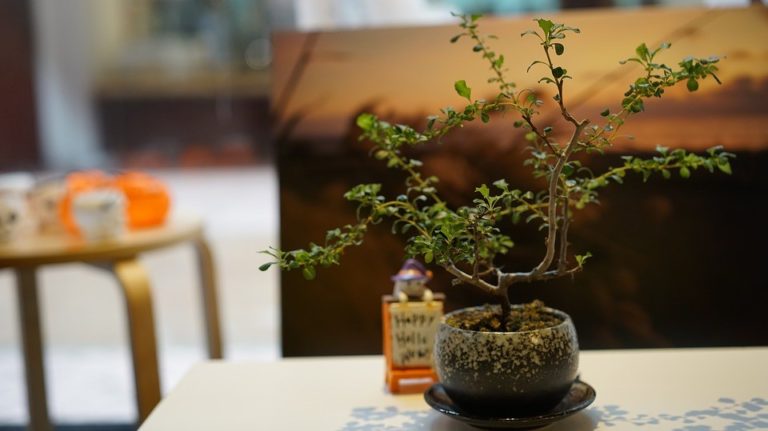
If you’re planning to grow an office bonsai, you’ll need to consider specific requirements. Not many species can withstand air conditioning, which may dry out the air and cause lower humidity levels. You’ll also need to check the ratio of natural to artificial light so that it receives enough of the former. Still, here are some bonsais that perform well in office environments.
- Japanese Red Maple (Acer palmatum)
- Sacred fig (Ficus religiosa)
- Jade Crassula (Crassula Ovata)
- Small Leaf Jade (Portulcaria afra)
- Dwarf Hawaiian Umbrella (Schefflera arboricola)
- Bougainvillea
- Money Tree / Guiana Chestnut (Pachira aquatica)
Developing Bonsai for Your Business
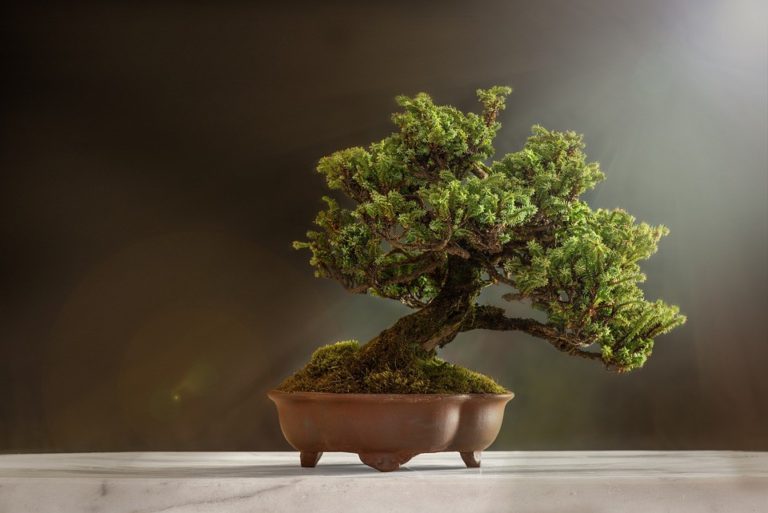
Once you’ve become a bonsai expert, you may be interested in selling them locally or online to fellow enthusiasts. While you can market any species, there are some that sell more than others. It also depends on your region and how available they are. For the most part, you’ll find the following bonsai trees tend to perform well.
- Chinese Elm (Ulmus parvifolia)
- Japanese Black Pine (Pinus thunbergii)
- Canadian hemlock (Tsuga canadensis)
- Korean Hornbeam (Carpinus coreana)
- Silver Birch (Betula pendula)
- Any Ficus
- Japanese Red Maple (Acer palmatum)
Gifting Bonsais
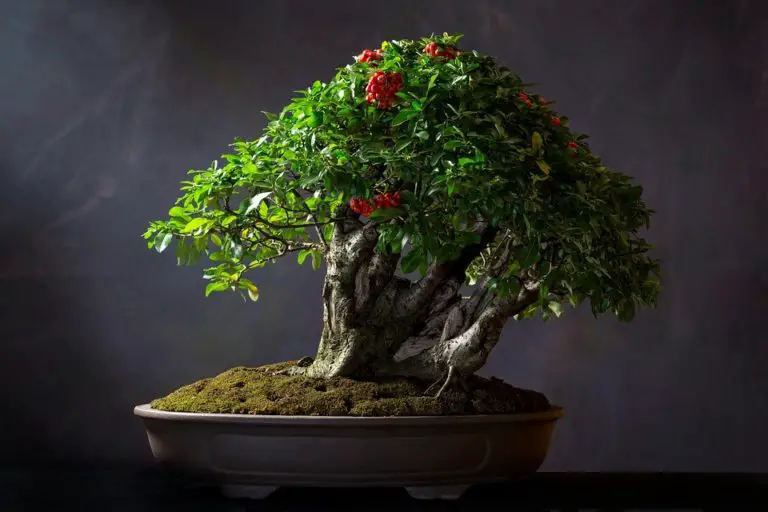
Deciding which species to buy as a bonsai gift depends on the recipient. You need to assess their knowledge and how well they’ll be able to care for it. Other aspects that might come into play are flowers, leaves, maintenance, style, container, location, and care requirements. Here are the most common bonsais bought as gifts.
- Ginseng Fig (Ficus retusa)
- Money Tree / Guiana Chestnut (Pachira aquatica)
- Small Leaf Jade (Portulcaria afra)
- Chinese Elm (Ulmus parvifolia)
- Chinese Juniper (Juniperus chinensis)
- London Plane (Platanus × acerifolia)
- Coral Tree (Erythrina lysistemon)
Bonsais That Have Stood The Test of Time
One of the factors that enthusiasts enjoy is that some bonsai species can grow for hundreds of years. While they’ll outlive us, they continue to carry our legacy with them. It shows patience and care, providing an example to all of us that live busy lives.
One of the oldest living species is the Ginkgo biloba. Scientists state that it dates back to Middle Jurassic during the time of the dinosaurs. It is the only surviving genus in its order, and owning one is a wonder to guests and traditionalists alike.
Not only is the Ficus genus beloved for being excellent as an indoor and outdoor bonsai, but it can live for an incredibly long time. The Ficus retusa Linn at Parabiago, Italy, is more than 1,000 thousand years old. It’s believed to be the oldest living bonsai in the world, speaking wonders for the plant kingdom.
Of course, another beloved genus is the Juniper. These hardy shrubs and trees can also live for more than 1,000 years, as can be witnessed at the Omiya Bonsai Village in Japan. A close second is the Shimpaku Juniper, which is 700 years old and stays in the same nursery. It just goes to show how long they can live if you maintain them properly.
The Akao Herb & Rose Garden holds a magnificent Red Pine that’s so huge you wouldn’t think it’s a bonsai. Supported by beams and a massive container, it’s more than 600 years old. If you’re thinking of owning a pine tree, expect it to survive for hundreds of years if you look after it.

How Different Bonsai Types Help You Build Stronger Relationships
Whether you’re having troubles in your relationship or want to build a stronger connection, caring for a bonsai can help both of you. There are specific spiritual and therapeutic elements held within different types of bonsai trees. By spending time together focusing on these aspects, you’ll soon find most of your troubles dissolving as you learn to work together.
The first aspect is support and structure. Soil provides both for the root system, holding everything in place. However, if you don’t inspect it often, you may find root rot or dry roots. It requires a careful balance. Bonsais that represent strong structure include Ficus and Elms.
You’ll also need to practice patience with each other, as you do with your bonsai. It takes time for the tree to grow, and you’ll need to nurture it every step of the way. You can’t rush quality, so you’ll need to take your time to watch it flourish. Bonsais that grow slowly and will help you with patience include Pines and Cypresses.
Seasonal care is another bonsai element that relates to relationships. Everyone experiences ups and downs, and you’ll need to react to each situation as it arrives. It’s essential to dish out affection when it’s really needed while ensuring you provide strength during difficult times. Deciduous trees that change during seasons are ideal for this, such as Japanese Maples and London Planes.
Finally, it’s essential that you don’t neglect each other. It’s easy to take each other for granted when things are going well. Remember to always communicate with each other, expressing fears and dreams. To ensure you continue to pay attention, you’ll need bonsais that require constant care, such as Pine, Almond, and Peach trees.
Can any Tree be a Bonsai?
Since bonsais are miniature versions of trees, many beginners believe you can turn any tree into a bonsai. While this is mostly true, there are many species not suited to this art form. Their structure isn’t comfortable with the small shapes, and it can be challenging reducing leaves and branches into smalls sizes.
The roots can also be complicated. Some species have massive root systems that are difficult to contain in a small pot. More often than not, you need to settle for a massive container, which means growing a huge bonsai. You’ll also have trouble with maintenance.
This point brings us to pruning; some trees don’t enjoy back budding or too much trimming. As a matter of fact, they may die if you cut off too many leaves at a time.
So, while you can probably bonsai any tree, it doesn’t mean that you should.
Final Thoughts
As you can see, there are different types of bonsai trees for various occasions and situations. As collectors, Bonsai Alchemist likes to obtain various kinds according to genera and families. However, you might want to look into finding the right ones that suit you. We hope that this guide has helped you in that regard.








0 Responses
Hi,
Want to dominate your local market and show up everywhere your customers search?
This Local Search Super Circle strategy builds your business visibility across 50+ high-authority platforms, boosting your Google Maps rankings, local SEO, and trust signals—fast.
✅ Perfect for service businesses, agencies, or local stores
✅ Built by an expert with proven local ranking results
✅ Done-for-you, no tech skills needed
Stand out locally.
Get found. Grow faster.
Claim Your Visibility Boost Now
https://tinyurl.com/ye28x78s